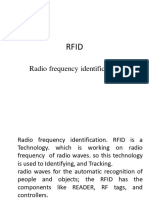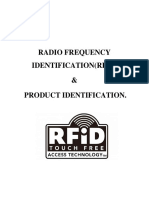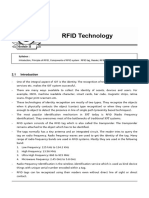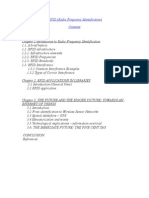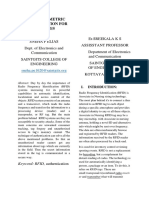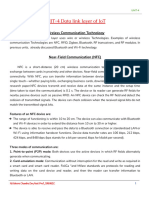No. Content: Table of Contents
No. Content: Table of Contents
Uploaded by
Bella NazaruddinCopyright:
Available Formats
No. Content: Table of Contents
No. Content: Table of Contents
Uploaded by
Bella NazaruddinOriginal Title
Copyright
Available Formats
Share this document
Did you find this document useful?
Is this content inappropriate?
Copyright:
Available Formats
No. Content: Table of Contents
No. Content: Table of Contents
Uploaded by
Bella NazaruddinCopyright:
Available Formats
TABLE OF CONTENTS
No. 1. 2. 3. 4. 5. 6. 7. DEFINITION FUNCTION
Content
Page 1 2 3 4 5 6 7
OPERATION/RESPONSIBILITY SIMILARITIES AND DIFFERENCES RELATED INFORMATION CONCLUSION REFERENCE
1|RFID Reader & Bar Code Reader
DEFINITION
RFID Reader
RFID reader is a transmitter and receiver that read the contents of RFID tags in the vicinity. It also called an RFID interrogator. The maximum distance between the reader's antenna and the tag vary, depending on application. Credit cards and ID badges have to be brought fairly close to the readers, somewhat like bar codes. For other applications, passive RFID tags can be read up to approximately 10 feet away, while active tags with batteries can be several hundred feet from the reader.
Bar Code Reader
A barcode reader also known as barcode scanner is an electronic device for reading printed barcodes. Like a flatbed scanner, it consists of a light source, a lens and a light sensor translating optical impulses into electrical ones. Additionally, nearly all barcode readers contain decoder circuitry analyzing the barcodes image data provided by the sensor and sending the barcodes content to the scanners output port. There are five basic kinds of barcode readers, pen wands, slot scanners, Charge-Couple Device (CCD) scanners, image scanners and laser scanners.
2|RFID Reader & Bar Code Reader
FUNCTIONS
RFID Reader
An RFID reader functions is to interrogate RFID tags. The means of interrogation is wireless and because the distance is relatively short, line of sight between the reader and tags is not necessary. A reader contains an RF module which acts as both a transmitter and receiver of radio frequency signals. The transmitter consists of an oscillator to create the carrier
frequency, a modulator to impinge data commands upon this carrier signal and an amplifier to boost the signal enough to awaken the tag. The receiver has a demodulator to extract the returned data and also contains an amplifier to strengthen the signal for processing. A microprocessor forms the control unit which employs an operating system and memory to filter and store the data. The data is now ready to be sent to the network.
Bar Code Reader
A barcode reader (or barcode scanner) is an electronic device for reading printed barcodes. Like a flatbed scanner, it consists of a light source, a lens and a light sensor translating optical impulses into electrical ones. Additionally, nearly all barcode readers contain decoder circuitry analyzing the barcode's image data provided by the sensor and sending the barcode's content to the scanner's output port.
3|RFID Reader & Bar Code Reader
OPERATION/RESPONSIBILITY
RFID Reader
RFID belongs to a group of technologies referred to as Automatic Identification and Data Capture (AIDC). AIDC methods automatically identify objects, collect data about them, and enter those data directly into computer systems with little or no human intervention. RFID methods utilize radio waves to accomplish this. At a simple level, RFID systems consist of three components: an RFID tag or smart label, an RFID reader, and an antenna. RFID tags contain an integrated circuit and antennas, which are used to transmit data to the RFID reader. The reader then converts the radio waves to a more usable form of data. Information collected from the tags is then transferred through a communications interface to a host computer system, where the data can be stored in a database and analyzed at a later time.
Bar Code Reader
Barcode scanners begin by illuminating the code with red light. The sensor of the barcode scanner detects the reflected light from the illumination system and generates an analog signal with varying voltage that represent the intensity (or lack of intensity) of the reflection. The converter changes the analog signal to a digital signal which is fed to the decoder. The decoder interprets the digital signal, does that math required to confirm and validate that the barcode is decipherable, converts it into ASCII text, formats the text and sends it to the computer the scanner is attached to.
4|RFID Reader & Bar Code Reader
SIMILARITIES AND DIFFERENCES
Similarities
RFID Readers Using scanning method.
Bar Code Readers
RFID and Barcodes convey information, making them suitable for a variety of different environments. Intelligent behavior
Differences
RFID Readers Uses radio waves, which doesnt need line of sight, to get the data RFID scanners can process dozens in a single second More complex and secure
Bar Code Readers Uses a sensor and light to read the data on the tag Can only process tags one at a time
Really simple and can be easily replicated or counterfeited
RFID tags can be hidden to protect against the environment Substantial pricier
Barcodes need to be exposed
Very cheap
5|RFID Reader & Bar Code Reader
OTHER RELATED INFORMATION
The major disadvantages of both RFID and BAR CODES are as follows:
Presence of obstacles. A bar code reader cannot read a bar code if there is any obstacle between the reader and the bar code. An RFID reader, depending on its operating frequencies and other factors, such as power and duty cycle, might not be able to read a tag if there are any RF-opaque obstacles, such as metal or RF-absorbent material, such as water present between the reader and the tag.
Presence of moisture. For bar code readers, the light beam might be refracted by water particles suspended in the atmosphere, resulting in focus distortion. For RFID readers operating in UHF and microwave frequencies, water particles suspended in the atmosphere might absorb RF energy, resulting in insufficient energy reaching the tags for proper data transfer.
Speed. If the scan rate of a reader is exceeded by the speed of movement of the bar codes, a loss of reading accuracy, together with failure to read a bar code, might result. For RFID readers, if the speed of the tag is so great that the tag has insufficient time to optionally energize itself properly and transmit data back to the reader, a loss of reading accuracy, together with failure to read a tag, might result.
Extrinsic identification schemes. A bar code or an RFID has to be applied externally to an object; these are not part of the object's physical characteristics. Therefore, if such an object is mislabeled or miss-tagged, the object identity is in jeopardy. However, perhaps intrinsic properties could be used to uniquely identify an object. For example, a fingerprint or a retinal scan of a person can uniquely identify this person without any need to put an external identification scheme, such as a bar code or RFID tag, on the person.
6|RFID Reader & Bar Code Reader
CONCLUSION
A comparison to bar codes did not make RFID look as promising as the current hype makes it out to be. In fact, you might be wondering whether RFID is heading toward failure because it cannot replace bar codes. This is a completely incorrect opinion! Although it might be true that RFID will not replace bar codes, such a fact does not herald the demise of RFID technology. Why? Because there is life beyond bar codes! No law states that RFID must replace bar codes to be successful. An untold number of applications for which bar codes are totally out of context represent a wide opening for RFID. Examples of these applications include smart tags, anti-tampering tags, and tags to locate objects in real time; for these scenarios, RFID might just be the right technology.
The problem with the bar code versus RFID debate does not have to do with the technology, but with the misguided zeal to prove the superiority of RFID. Hype that one of the most prevalent technologies today will be defeated soon attempts to make people notice and accept RFID. As it turns out, however, such hype targets a competing technology that is hard to defeat with the current state of RFID technology.
7|RFID Reader & Bar Code Reader
REFERENCE
RFID Sourcebook CSC134 Computer and Information Processing Textbook Internet :http://www.rfidreader.com/ http://abrfid.wpengine.com/rfid-vs-barcodes/ http://www.ehow.com/facts_7470883_difference-between-rfid-barcode_.html http://www.technovelgy.com/ct/Technology-Article.asp?ArtNum=60
8|RFID Reader & Bar Code Reader
You might also like
- Study and Measurement of Losses in Optical FiberDocument3 pagesStudy and Measurement of Losses in Optical FiberRockShayar Irfan Ali Khan100% (1)
- What Is RFID? Definition and ExampleDocument4 pagesWhat Is RFID? Definition and ExampleBastian Nugraha SiraitNo ratings yet
- RFIDDocument7 pagesRFIDvinit PatidarNo ratings yet
- RFIDDocument31 pagesRFIDSameer Kapoor100% (1)
- Vehicle Tracking and Ticketing System Using RFID Muy Bueno Pero en Ingles ImagenesDocument32 pagesVehicle Tracking and Ticketing System Using RFID Muy Bueno Pero en Ingles ImagenesFé GabrielaNo ratings yet
- T.Mohanapriyaa-Iii Eee P.Priya-Iii Cse M.Kumarasamy College of Engineering Thalavapalayam KarurDocument11 pagesT.Mohanapriyaa-Iii Eee P.Priya-Iii Cse M.Kumarasamy College of Engineering Thalavapalayam KarurSindhuja SambuNo ratings yet
- RfidDocument12 pagesRfidminakshiNo ratings yet
- Radio Frequency IdentificationDocument16 pagesRadio Frequency IdentificationPinkal PatelNo ratings yet
- RFID vs. Barcode (ICA Assignment) - Muddasir Ali Soomro: Bar CodeDocument4 pagesRFID vs. Barcode (ICA Assignment) - Muddasir Ali Soomro: Bar CodeSalman KhalidNo ratings yet
- RfidDocument19 pagesRfidBhumika ReddyNo ratings yet
- Radio Frequency: Identification (Rfid) TechnologyDocument16 pagesRadio Frequency: Identification (Rfid) TechnologyhashmudeNo ratings yet
- Understanding Radio Frequency Identification (RFID)Document8 pagesUnderstanding Radio Frequency Identification (RFID)Rahul PatelNo ratings yet
- AbstractDocument5 pagesAbstractpayalwaniNo ratings yet
- RFIDDocument18 pagesRFIDGowtham S ShettyNo ratings yet
- Final Rfid Report1Document35 pagesFinal Rfid Report1priyaNo ratings yet
- VTSDocument22 pagesVTSmadhu_15777No ratings yet
- Technology Radio Waves: Radio-Frequency Identification (RFID) Is ADocument9 pagesTechnology Radio Waves: Radio-Frequency Identification (RFID) Is ANeha GambhirNo ratings yet
- BY:-Saswati Sucharita Jena Cse BranchDocument19 pagesBY:-Saswati Sucharita Jena Cse BranchnibhakumariNo ratings yet
- Rfid Solution DesignDocument3 pagesRfid Solution Designkrishanu1013No ratings yet
- Rfid Full DetailDocument11 pagesRfid Full Detailgokul_rajNo ratings yet
- Radio Frequency Identification DRHUDADocument16 pagesRadio Frequency Identification DRHUDAAnonymous xZLiWx8ln0No ratings yet
- Rfid FinalDocument38 pagesRfid FinalSaloni JainNo ratings yet
- Human ID Implant Seminar ReportDocument23 pagesHuman ID Implant Seminar Report20261A3232 LAKKIREDDY RUTHWIK REDDYNo ratings yet
- Radio Frequency Identification 2369Document27 pagesRadio Frequency Identification 2369Dharmendra YadavNo ratings yet
- What Is RFID and How Does RFID Work - AB&R®Document4 pagesWhat Is RFID and How Does RFID Work - AB&R®akshta agarwalNo ratings yet
- RFID-The Next Big Thing' in IT: - K.Nithya III Yr, CSE - B'Document5 pagesRFID-The Next Big Thing' in IT: - K.Nithya III Yr, CSE - B'anon-184353No ratings yet
- Assignment On RFID For Agricultural Purpose and Its Different Business UtilizationDocument10 pagesAssignment On RFID For Agricultural Purpose and Its Different Business UtilizationJanhvi JaiswalNo ratings yet
- IOT Unit2 Class4Document3 pagesIOT Unit2 Class4AIEMP EXAMCELLNo ratings yet
- R F ID: Understanding Adio Requency Entification (RFID)Document15 pagesR F ID: Understanding Adio Requency Entification (RFID)Rohan KelkarNo ratings yet
- N Recent YearsDocument10 pagesN Recent YearsMukesh KumarNo ratings yet
- Radio Frequency Identification For Product IdentificationDocument18 pagesRadio Frequency Identification For Product IdentificationSalau DamilolaNo ratings yet
- Development of User Identification Code of A Car SynopsisDocument10 pagesDevelopment of User Identification Code of A Car Synopsismehak90No ratings yet
- SSM College of Engineering: Diver Parishaspora Pattan, Baramulla, Kashmir-193121Document21 pagesSSM College of Engineering: Diver Parishaspora Pattan, Baramulla, Kashmir-193121koonai52No ratings yet
- Mca Rfid ReportDocument19 pagesMca Rfid Reportrtpatil76No ratings yet
- Radio Frequency IdentificationDocument3 pagesRadio Frequency IdentificationSarras Info100% (1)
- Rfid ReaderDocument5 pagesRfid ReaderPrakash GDNo ratings yet
- Chap 2Document8 pagesChap 2abhishekshirke502No ratings yet
- Multiresonator-Based Chipless RFIDDocument20 pagesMultiresonator-Based Chipless RFIDVijayNo ratings yet
- Radio Frequency IdentificationDocument38 pagesRadio Frequency IdentificationpriyalNo ratings yet
- Architecture of RFIDDocument4 pagesArchitecture of RFIDJay MehtaNo ratings yet
- RFID Modules & Guideline For Selecting Appropriate RFID Module For IndustriesDocument4 pagesRFID Modules & Guideline For Selecting Appropriate RFID Module For IndustriesInternational Journal of Application or Innovation in Engineering & ManagementNo ratings yet
- RFID in Library AutomationDocument4 pagesRFID in Library Automationakashlogic100% (1)
- Ijirt147791 PaperDocument6 pagesIjirt147791 PaperDiego PinheiroNo ratings yet
- Radio Frequency Identification RFIDDocument41 pagesRadio Frequency Identification RFIDmtawba100% (4)
- Automatic Door Unit Radio Frequency Identification (RFID) Based Attendance SystemDocument12 pagesAutomatic Door Unit Radio Frequency Identification (RFID) Based Attendance SystemthgnguyenNo ratings yet
- How RFID WorksDocument2 pagesHow RFID WorksDev DangNo ratings yet
- Vehicle Tracking and Ticketing System (VTTS) Using RFID (Complete Softcopy)Document56 pagesVehicle Tracking and Ticketing System (VTTS) Using RFID (Complete Softcopy)Hari Krishnan MA100% (129)
- Wireless Network Technologies Assignment-2 Part 2Document20 pagesWireless Network Technologies Assignment-2 Part 2Ayola JayamahaNo ratings yet
- Bar Codes and RFID Technology Use To University Library ManagementDocument5 pagesBar Codes and RFID Technology Use To University Library ManagementerpublicationNo ratings yet
- RFID Based Attandance Cum Security SystemDocument12 pagesRFID Based Attandance Cum Security SystemAmit ChauhanNo ratings yet
- Secure Symmetric Authentication For Rfid TagsDocument5 pagesSecure Symmetric Authentication For Rfid TagsSneha SajiNo ratings yet
- UNIT-4 Data Link Layer of IoTDocument20 pagesUNIT-4 Data Link Layer of IoTnimmaladinesh82No ratings yet
- Synopsis RfidDocument10 pagesSynopsis RfidneomayankNo ratings yet
- Rfid & E-BusinessDocument9 pagesRfid & E-BusinessSambodhi MajiNo ratings yet
- RFIDDocument8 pagesRFIDAishwarya NaikNo ratings yet
- RFID Systems: Research Trends and ChallengesFrom EverandRFID Systems: Research Trends and ChallengesRating: 5 out of 5 stars5/5 (1)
- Radio Frequency Identification: Fundamental Ideas And Principles Concerning RFIDFrom EverandRadio Frequency Identification: Fundamental Ideas And Principles Concerning RFIDNo ratings yet
- RFID Handbook: Fundamentals and Applications in Contactless Smart Cards, Radio Frequency Identification and Near-Field CommunicationFrom EverandRFID Handbook: Fundamentals and Applications in Contactless Smart Cards, Radio Frequency Identification and Near-Field CommunicationNo ratings yet
- Non-Linearities in Passive RFID Systems: Third Harmonic Concept and ApplicationsFrom EverandNon-Linearities in Passive RFID Systems: Third Harmonic Concept and ApplicationsNo ratings yet
- Arduino Applied: Comprehensive Projects for Everyday ElectronicsFrom EverandArduino Applied: Comprehensive Projects for Everyday ElectronicsNo ratings yet
- Behringer Ultra-DI DI100 SpecsDocument1 pageBehringer Ultra-DI DI100 SpecsRick McGuireNo ratings yet
- ARM7 TDMI Manual Pt3Document46 pagesARM7 TDMI Manual Pt3Lokesh KalyanarajNo ratings yet
- VGA Video Signal GenerationDocument34 pagesVGA Video Signal Generationgongster100% (14)
- 1+1 HSB SD FD CommissioningDocument28 pages1+1 HSB SD FD CommissioningDiah Nurani94% (16)
- COM2520 - Assignment - 2020 PDFDocument4 pagesCOM2520 - Assignment - 2020 PDFlealoNo ratings yet
- 40HF (R) Series: Vishay SemiconductorsDocument1 page40HF (R) Series: Vishay SemiconductorsSIVARAMANJAGANATHANNo ratings yet
- 06 G-LII 304 Traffic Statistics Analysis-20071205-A-2.0Document69 pages06 G-LII 304 Traffic Statistics Analysis-20071205-A-2.0Bảo Hân NguyễnNo ratings yet
- Pulse Amplitude ModulationDocument21 pagesPulse Amplitude ModulationSuzette Sabido100% (4)
- Digital Design Interview Questions Part 1 - Vlsi4freshersDocument4 pagesDigital Design Interview Questions Part 1 - Vlsi4freshersMADDALA RAMYA (N170498)No ratings yet
- Spartan-3 Generation FPGA User GuideDocument524 pagesSpartan-3 Generation FPGA User Guidemar_barudjNo ratings yet
- 2007 - Sony Product GuideDocument23 pages2007 - Sony Product GuideSeanNo ratings yet
- SCADAPack 350 DatasheetDocument6 pagesSCADAPack 350 DatasheetWiedNo ratings yet
- IEEE White Paper Capacitor Application IssuesDocument14 pagesIEEE White Paper Capacitor Application IssuesVenkat DegaNo ratings yet
- AR9002AP-1S: AP/Router Solution Based On 802.11n 1-Stream SpecificationDocument2 pagesAR9002AP-1S: AP/Router Solution Based On 802.11n 1-Stream SpecificationAsep AcengNo ratings yet
- E-Ball Technology: Concept of PCDocument24 pagesE-Ball Technology: Concept of PCLoki AbcNo ratings yet
- Polytechnic Spot Counseling NoticeDocument16 pagesPolytechnic Spot Counseling NoticeMUSICMG MusicMgNo ratings yet
- Level 3 Repair: 8-1. Block DiagramDocument31 pagesLevel 3 Repair: 8-1. Block DiagramJairo RegaladoNo ratings yet
- Chapter 2. TransistorsDocument69 pagesChapter 2. TransistorsAnh Ha Duy AnhNo ratings yet
- Reference Books:: ICT 6612: Advanced Optical CommunicationsDocument12 pagesReference Books:: ICT 6612: Advanced Optical CommunicationsRashed IslamNo ratings yet
- 8.0 Inch IPS MIPI 800x1280 AML08021016-31DDocument13 pages8.0 Inch IPS MIPI 800x1280 AML08021016-31DcalvinkleinwuNo ratings yet
- Ecx4233 Tma1 2016Document6 pagesEcx4233 Tma1 2016ParasecNo ratings yet
- EeeDocument14 pagesEeekvinothscetNo ratings yet
- JSSStandards JSS 5820-19-2006Document27 pagesJSSStandards JSS 5820-19-2006khanjrkhanNo ratings yet
- Week3 Assignment3 SolutionsDocument4 pagesWeek3 Assignment3 SolutionspvvNo ratings yet
- Programmable Logic Design With VHDLDocument198 pagesProgrammable Logic Design With VHDLDaniel CornelioNo ratings yet
- 00027636-B DCT1 Wiring DiagramDocument77 pages00027636-B DCT1 Wiring DiagramKarikalan JayNo ratings yet
- What Is Computer. Discribe Different Types of ComputerDocument27 pagesWhat Is Computer. Discribe Different Types of ComputerFiaz HussainNo ratings yet
- An Insight Into Single Section Digital Axle Counter (SSDAC-G36)Document52 pagesAn Insight Into Single Section Digital Axle Counter (SSDAC-G36)Sampreeth Nambisan PeriginiNo ratings yet
- CC2640 SmpleLink Bluetooth (Smart Wireless MCU)Document57 pagesCC2640 SmpleLink Bluetooth (Smart Wireless MCU)Lullaby summerNo ratings yet









